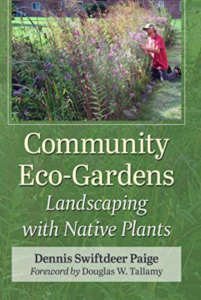Landscaping with Native Plants
 By Dennis Swiftdeer Paige
By Dennis Swiftdeer Paige
Published by McFarland Publishing
Reviewed by Georgia Harris
In his book Community Eco-Gardens, Dennis Swiftdeer Paige brings an optimistic and can-do attitude to his twenty-year project of creating a native landscape in a five-acre condo complex outside of Chicago.
Being worried about climate change has become a pastime of our modern world. In the current political climate that is so divisive and seems to lack understanding of the dire consequences facing the planet, Paige’s “What’s Done Can Be Undone” rallying cry emphasizes the power of a community. We can recognize the need to restore the land by working together with scientists, ecologists, educators, developers, municipalities, and businesses to create a community.
Paige attests that we do not need to thoroughly understand all ecological systems to understand their inherent value. Ecological systems filter water, capture carbon, and do many other services that we take for granted, but we need to protect these resources for future generations.
Paige’s energy is a delight in part, a memoir, and part a recipe book for building native planting gardens. Paige, always entranced by the natural world, gradually creates a native natural habitat in his residential Town Square Condominium Complex. Once a thriving marshland, the complex was forever altered by suburban growth.
Before putting a spade into the ground, he visits nearby nature preserves to observe understory plantings and how plants interact in their natural settings to more clearly understand native gardening. Paige starts small with a few beds under existing ash trees.
While he has the blessing of the condominium board, he has no monetary resources for this project. Looking for an inexpensive source of native plants, Paige joins a wildflower rescue organization called The Wild Ones. The Wild One’s Native plant hotline alerts members of native plants in danger of being destroyed due to construction; within a couple of weeks, Paige had enough free-rescued wildflowers to plant his first garden bed.
After planting over ten successful planting beds, eager to build more habitat, Paige set his sights on the condo complex’s acre and a half of open lawn. This open space could be planted with a grove of trees and an understory shrub layer, providing food and shelter for birds and insects while giving residents a closer view of nature and the calmness of being more closely connected to nature.
Not only is Community Eco-Gardens a how-to book with much practical advice in planting and procuring native plants, but it’s also an example of having a vision, working together, and moving forward through setbacks and triumphs. Engaging subtitles are sprinkled throughout the chapters like How to Keep Critters Out Without Hurting Them, Unanticipated Problems Arise, and New Birds on the Block Come to the Rescue. Indexes include a plant list with bloom times and habitat type, as well as guidelines for creating eco-gardens for homeowners associations, owners of large land tracts, and individual private homeowners.
We are a part of nature, and in caring for the natural world, we are taking time and caring for ourselves and future generations. Like Paige, anyone who has been gardening for years experiences roadblocks, be they weather, construction pressures, invasive plants or diseases. Gardening also brings the joy of creating a beautiful landscape and the thrill of a new technique to try. We should take a page from Paige’s book to expand the boundaries of possibilities with native plants, create habitat and perhaps a shared community along the way.
“Native landscaping returns to an ethical ancient practice which aims to generate a more harmonious place, not separating the laws of nature from our modern-day living. Educating communities in this direction helps bring people and nature back in balance with the planet.” -Dennis Swiftdeer Paige
About the Reviewer
Georgia Harris has been gardening for over 30 years. She is a member of Lexington Living Landscapes, Lexington Field & Garden Club, and editor of the ELA Newsletter. She is also a youth mentor with Silver Linings Mentoring. When not in the garden, she can be found practicing yoga, swimming or snuggling with her three cats.
***
Each author appearing herein retains original copyright. Right to reproduce or disseminate all material herein, including to Columbia University Library’s CAUSEWAY Project, is otherwise reserved by ELA. Please contact ELA for permission to reprint.
Mention of products is not intended to constitute endorsement. Opinions expressed in this newsletter article do not necessarily represent those of ELA’s directors, staff, or members.

